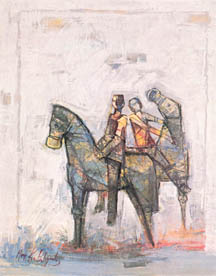
BRAVE NEW WORLD
By Stelios Lydakis
Art Critic and Professor - Athens University
The figures in the works of the German artist, Oscar Slemer (1888-1943) are motionless as if they are mannequins. They are frozen in a certain position and pose, and in this way, the relationship between them is abolished even though they co-exist.
One could talk about a silent ballet that suddenly and unexpectedly becomes immobile under the influence of some extraterrestrial force. The works of Slemer dated around 1930 should not be considered unrelated to the general spirit of "Alienation and Formality" of man. With the growth of the industrial society, Slemer's works take on an air of reality and threat.
It is 1932 the time when Aldus Huxley wrote his Brave New World a prophetic work of science fiction, which formalizes man's inhumanity in the future.
The typical man, the impersonal man, the robot man, - all become entangled in the net of ever increasing existential anxiety. It grows more and more until it breaks out in the Second World War without diminishing any of its strength. Man's behavior in industry during that time is shown in Slemer's works with a gentle appearance, a strange morbid silence that is akin to certain forms of surrealism.
Like the typical changes of energetic pathos and anxiety present in the works of the sculptor and artist Marino Marini (born 1901), the poses take on an imposing character. The puppets rebel, stretch and gesticulate the horses they are mounted on. They are shocked with despair and grief, and in this way they express the tragic feelings of the creatures, which according to Huxley are born from test tubes, devoid of sentimentality.

As one views the creatures of Slemer and Marini, and as Nikolas Berdiaeff has stated that today’s Utopias can be realized, the question still remains how we can rid ourselves of fantasies and most of all, those caused by our materialized fears.
Menelaos Katafigiotis was born in Trikala in the province of Thessaly, Greece during the period in which Slemer's robots and Marini's explosive units were appearing. As a representative of the mid World War II generation, Katafigiotis continued in the tradition of Slemer and Marini. In this way he developed his style while maintaining his pathos concerning the fate of man with the same ways and symbols as his first mentors.
Katafigiotis studied in the School of Fine Arts in Athens under great masters in art. In 1961 he went to Paris and then to the USA. He has established a vigorous exhibiting schedule showing works in many artistic centers of the world.
From an artistic point of view he is considered to be an expressionist. He contrasts chromatic tones of different textures, he stresses the outline forms and disorders his expressive figures, which consist mainly of people and horses. Bold graphic elements are seen in all cases, which either preserve the stillness or else the vigorous moving figures. Whoever possesses expressionistic ideas is engulfed in worries and problems that are essential elements in being an expressionist. Katafigiotis surrounds the paragon man and attempts to see the drama of man. But in this case, do we have the simple repetition of an old motif and nothing else? Basically yes -as history continues, so do the problems that concern man in this century.
From the time Huxley wrote Brave New World until today, things are progressively getting worse. It looks as if our HOMO FABER has lost all of his emotions except for one-fear-and does nothing to avoid it. On the contrary he has given in with a great deal of masochistic exultation. He coexists with fear but ignores its existence. Therefore the chaos is Ante Portas. Katafigiotis stands in front of fear like another Jeremiah, painting the vibrations created by his life and vision.
"The sun was already high when he awoke. He lay for a moment, blinking in owlish incomprehension at the light; then suddenly remembered - everything. Oh, my God, my God! ..." - From the end of "Brave New World."
